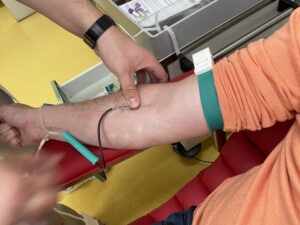If there’s one exercise that should win the gold for its impressive list of benefits — and minimal risks — it’s walking. It’s convenient (just think, no equipment!) and it’s contraindicated for very few conditions and co-morbidities.
You may be wondering: If it’s an activity that can help someone in their nineties stay fit — can it really provide benefits for everyone?
Yes, people of all ages and fitness levels, from newbies to elite-level athletes, can get many of the same benefits running provides by doing walking workouts — with the right techniques.

When Is Walking a Workout?
When it comes to exercise, walking is an ideal place to start. “Walking is for all levels in the fitness journey. You can do it anywhere, from marching in place while sitting in a chair to challenging yourself with power walking,” says Carrie Boyle, a walking coach with 99 Walks, a virtual walking program, as well as a NASM-certified personal trainer.
When does walking qualify as a workout rather than a few steps here and there to toss laundry in the dryer or get a snack from the kitchen? Those types of steps and the steps you take on a designated walk (like a 30-minute walk through your neighborhood or an afternoon hike) are all valuable for your overall wellness. “All steps, regardless of intensity, count toward our physical activity and can have health benefits,” says Amanda Paluch, Ph.D., an assistant professor at the University of Massachusetts in Amherst who researches physical activity epidemiology and kinesiology. (Though factors like speed and incline grade can certainly make some steps more intense than others.)
Walking falls into the category of moderate-intensity aerobic exercise when you walk at a pace that quickens your breathing somewhat (though you should still be able to have a conversation comfortably).right up arrow The Centers for Disease Control and Prevention (CDC) recommends that adults get at least 150 minutes of this type of activity per week to promote cardiovascular health and lower the risk of other chronic diseases and note that more exercise is generally linked with more health benefits. That means five 30-minute walks per week can fulfill that cardiovascular exercise recommendation, as long as you’re walking at a challenging enough pace to make it moderate intensity.
On the other hand, there are no official recommendations for how many steps to take per day, says Dr. Paluch, whose research focuses on the health benefits of daily step counts. The common advice, to aim for 10,000 steps per day, is actually based on little scientific evidence, with some research suggesting just 7,500 steps per day may be a more significant threshold for improved health.
While it’s important to speak with your physician before embarking on any new exercise routine, especially if you have a chronic condition like heart disease or asthma, walking is safe for most people, says James N. Robinson, MD, a sports medicine physician at the Hospital for Special Surgery in New York City.
Other problems, such as knee injuries or spine osteoarthritis, can be aggravated by walking, too. If you have an injury or other chronic health problem that might be made worse with walking, it’s a good idea to speak with your physician before you start a walking workout regimen. It may be better to try a lower-impact sport, such as stationary bike riding or swimming, Dr. Robinson says.
The Health Benefits of Walking
One benefit is a longer life. Just by walking at a pace that makes you slightly out of breath or sweaty, you may lower your risk of heart disease and death from all causes than with regular walking at a more leisurely pace, research finds. That same brisk walking can also lower your risk of high cholesterol, high blood pressure, and diabetes as much as running does.
Science has found a link between walking and improved cognitive function over time.
Walking has also been shown to improve symptoms in people with knee osteoarthritis. For some, it can help lessen chronic back pain, according to data from a small study. And a small study found that simply taking more steps during the day was linked to improved sleep quality (and more so for women than for men).right up arrow It’s worth noting that any physical activity throughout the day (compared with none) can benefit sleep.
Walking can also help prevent bone loss that happens naturally as a result of age, particularly if you up the intensity of your steps by climbing stairs, pick up the pace, or add bodyweight exercises (like push-ups or squats) throughout your walk.
And it’s also worth noting that the CDC’s physical activity guidelines for adults define brisk walking as one of the types of moderate exercise linked with optimal long-term health, including a lower risk of excess weight gain.
The mental benefits of walking are equally impressive (which should come as no surprise given that exercise overall is one of the top ways to manage stress). Walking is indeed a great stress reliever, says Juliet Kaska, a Los Angeles–based ACE- and NASM-certified personal trainer and the founder of Juliet Kaska’s Zen Fitness. A study, for example, showed that people who participated in at least one group walk in nature per week saw positive effects when it came to managing stressful life events and improving mental well-being. Research has even shown that walking can improve creative thinking, even more so when the walk is done outside.
Is Walking Good for Weight Loss?
Walking is a great addition to a healthy diet for weight loss, says Monique Ryan, RDN, a sports nutritionist who is a certified specialist in sports dietetics in private practice in Evanston, Illinois.
Walking (like all forms of physical activity) burns calories, and can create the calorie deficit you need to lose weight. It’s a little more complicated than just calories in versus calories out, but a general rule of thumb is that you need to burn more calories in a day (through movement and basic body functioning) than you consume (through food) in order to lose weight, Ryan says.
The calories you burn walking will depend on how much you weigh and how fast you’re walking. A 140-pound person walking briskly for 30 minutes, for example, will burn 127 calories.
Use online calorie calculators (like the one from the Calorie Control Council) or wearable technology to find and track your own numbers. A registered dietitian who specializes in weight loss can also help tailor a walking and healthy-eating plan to help you meet weight loss goals.
If you know how many calories you’re actually burning on your walks (if you’re trying to watch calories or lose weight) you won’t overestimate energy expenditure and calorie needs — and derail your weight loss efforts by overeating, Ryan says. “It’s easy when you’re just starting a walking program to think you’re burning more calories than you actually are.”
Nutrition Tips: What to Eat Before, During, and After a Walking Workout
You shouldn’t have to pay too much attention to pre-workout fueling for moderate walking if you’re planning to walk for under an hour or so. You might not even need to fuel at all depending on when you last ate (more on that below).
For more moderate walks, Ryan says: “Think about the time of day you walk and your meal pattern.” Do you like walking in the morning? Let breakfast settle for a bit and head out for your walk — you’ll have plenty of gas in the tank for each step. Conversely, advises Ryan, if you prefer to walk as soon as you wake up, drink water to hydrate before the walk (no matter the temperature outside) and plan for an easy-paced walk since you’ll be hoofing it on an empty stomach.
What about mid-walk eats? It’s really only necessary if you know you’re going to be out on a walk for longer than an hour, says Ryan. In that case, aim for a snack with about 30 grams of carbohydrates per hour. She recommends a sports drink for some calories and hydration. Or, refuel with dried fruit or your favorite energy bar (and water).
When you get home from your walk, simply rely on your next meal or snack, says Ryan.
How to Get Started With Walking Workouts
Fortunately, walking for fitness comes with almost no learning curve. It’s different from a casual stroll with your best friend or dog (where you may be moving at a slower pace), but it’s easy to do with some extra attention to your speed and form. Here’s what beginners need to know to feel strong on their feet.
Plan Your Route
If you’re brand-new to walking, find a location where you can make small loops, which allows you to continually pass by your starting point, says Boyle. This allows you to listen to your body and reassess your capacity.
As you loop once around, ask yourself: How do I feel? If you feel good, then go around one more time. “Don’t put stress on yourself to take these big walks right off the bat. Sometimes you’ll go five minutes, and that’s totally fine,” she says.
Watch Your Speed
Part of what makes walking a workout (or not) is attention to speed. “One of the biggest mistakes beginners make is picking a pace that’s so fast that it’s not sustainable for more than a few minutes,” says walking coach Dave McGovern, a 15-time U.S. champion race walker and author of The Complete Guide to Competitive Walking. “Alternatively, some beginners walk so slowly that they are getting little cardiovascular benefit.”
If you want to boost fitness, brisk walking is best; what counts as “brisk” will depend on your current fitness level. If you’re new to walking for fitness or to exercise overall, shoot for a 20-minute mile to start, says Bonnie Stoll, a personal trainer in Los Angeles and a co-founder of EverWalk, a movement designed to get people walking more. Otherwise, see if you can move at a 15-minute-mile pace.
Another way to gauge your speed and intensity: Pay attention to your breathing. If you’re walking briskly, you should be breathing heavier, but still, be able to carry on a conversation. If you are out of breath and would not be able to chat with a person next to you, slow down.
Mind Your Form
Want to improve that speed? Make sure you’re using a heel-toe motion in your feet. “Pretend you have somebody behind you and you want to show them what’s on the bottom of your shoe with each step,” Stoll says. That roll through your foot should help propel you forward.
At the same time, hold your arms at 90-degree angles and pump them forward and back, not across your body. “As you increase your elbow pump, your feet will follow,” Stoll says, adding that if you swing them across your body, it may impede your speed.
Now get a baseline reading of how long it takes you to walk a mile. Head to a track (or loop) and log the time it takes you to complete one lap, usually one-quarter mile. Do a second lap and see if you can walk just five seconds faster, Stoll says.
Set Your Schedule
Walking may be an everyday activity, but you shouldn’t do a true walking workout every day. Allow for at least one day of rest per week, Boyle says. During that rest day, you can take a short, casual stroll, plan a cross-training day (for example, swim or ride your bike at an easy pace), or take a full recovery day without physical activity.
Getting Better: How to Make Walking a Higher-Intensity Workout
Walking can be a challenging form of exercise for people at all fitness levels. But the same types of walks won’t be challenging for everyone. Bump up the intensity with these strategies.
Walk up and down hills. To build strength and stamina, find a hilly route to walk, or do hill repeats, walking up and down one hill several times in a row. Keep some form tips in mind. “Lean forward slightly when walking uphill,” Kaska says. And because going downhill can be hard on the knees, take shorter steps, keep your knees slightly bent and slow your pace.
Do intervals. Intervals alternate between periods of high-intensity work and periods of recovery. Walk as fast as you can for a given amount of time, then slow down the pace. Try, for instance, walking for two or three minutes at a moderate intensity and then going fast for one minute. Or if it’s easier, alternate one minute of fast and one minute of slower walking. If going by the clock is too cumbersome, then use visible markers like mailboxes or trees and speed up between every fourth and fifth mailbox or tree, Stoll says.
Choose different terrain. Pavement is always a good choice, but make an effort to try other surfaces. “You can burn more calories by walking on grass or gravel than a track,” Kaska says. Bonus? If you live near a beach, hit the sand and you’ll increase that calorie burn.
Use Nordic walking poles. Invest in a pair of poles designed specifically for Nordic walking, which can up the cardiovascular benefits of walking (because you get your upper body more involved). “It mimics cross-country skiing without the skis,” Kaska says. You can even purchase weighted walking poles, which you can use to add balance, stability, and resistance to your walks.
FAQs About Walking
Do I need to warm up before walking workouts? How?
Yes, it’s a good idea to warm up before walking. Do so by walking at a light, leisurely pace before picking it up. Or do some gentle movements, like leg swings and hip circles while holding on to a fence, or do walking toe touches and arm circles, to get the muscles you’ll use in gear, McGovern says.
How many calories does walking burn?
The number of calories you’ll burn on a walk depends on your weight, speed, and distance. For a 140-pound person, 30 minutes of brisk walking burns 127 calories.
What muscles do you use for walking?
Muscles in your lower body are recruited during a walk — glutes, hamstrings, quads, and calves are the major ones, says Boyle. You’ll also use arm muscles as you swing your arms; and your core, shoulders, and upper back activate to help you maintain posture.
Is there anyone who shouldn’t try walking workouts?
Most people can safely start a walking workout. If you have cardiovascular disease, check with your doctor first, Robinson says. If you have osteoarthritis, weight-bearing exercise (including walking), can aggravate the condition, he adds. Low-impact exercise (pedaling on a stationary bike or swimming) will limit discomfort.
What should I wear when I walk?
Most important is a pair of well-fitted running shoes. When purchasing a new pair, look for a low-heeled running shoe, says McGovern. As for clothing, choose comfortable breathable fabrics, such as cotton, and wear layers, Boyle says. That way if you get warm, you can remove a layer and tie it around your waist or carry it for the rest of your walk.
Are there any common walking injuries, and how can I avoid them?
Walking is a low-impact activity and generally comes with a low risk of injury if you’re wearing proper footwear, warming up before workouts, and ramping up time, speed, and distance gradually. But, it’s possible to develop what is called overuse injuries from walking, which is essentially injury from repeated movement that causes repetitive trauma. That may include knee and hip tendonitis or stress fractures in the legs and feet, says Robinson. Walking should be pain-free. If you feel a sharp pain that lingers after exercise, see a doctor.





































